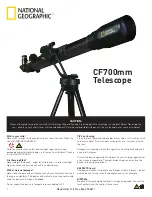
55
Train the telescope motors using AutoStar. Perform this procedure if you are experiencing any pointing accuracy
problems.
Fig. 33
depicts the complete Drive Training procedure.
NOTE:
Use a terrestrial object, such as a telephone pole or lamp post, to train the drive.
Complete this exercise once every 3 to 6 months to maintain the highest level of telescope
pointing accuracy.
Fig. 33: Training the Drive Procedure.
APPENDIX C: TRAINING THE DRIVE
Further Study....
This manual gives only the briefest introduction to astronomy. If
you are interested in pursuing further studies in astronomy, a few
topics are suggested below that are worth reading (some of the
topics are easy and some are quite challenging). Try looking up
some of these in the AutoStar glossary.
Also included below is a small sampling of books, magazines
and organizations that you might find helpful.
Topics
1.
How is a star born? How does a solar system form?
2.
How is the distance to a star measured? What is a light
year? What is red shift and blue shift?
3.
How are the craters on our Moon formed? Is there water
under the surface of the Moon?
4.
What is a black hole? A neutron star? A quark star? A
gamma burster? An Einstein lens?
5.
What are stars made of? Why are stars different colors?
How is the elemental composition of a star determined?
What is an Lyman Alpha forest?
6.
What is the difference between a Type I and a Type II
supernova?
7.
What is the importance of studying the composition of
comets? Where do comets come from?
8.
How old is our Sun? Will our Sun evolve into a planetary
nebula or go supernova?
9.
What is the Inflationary Big Bang? What is dark matter?
What are MACHO’s?
10. How are extrasolar planets discovered? What is an
accretion (or protoplanetary) disk?
11. What are the differences between elliptical, spiral and
irregular galaxies? Can globular clusters be older than the
universe itself?
Books
1.
The Guide to Amateur Astronomy by Jack Newton and
Philip Teece
2.
The Sky: A User’s Guide by David Levy
3.
Turn Left at Orion by Guy Consolmagno & Dan Davis
4.
Astrophotography for the Amateur by Michael Covington
Magazines
1.
Sky & Telescope
Box 9111, Belmont, MA 02178
2.
Astronomy
Box 1612, Waukesha, WI 53187
Organizations:
1.
Astronomical League
Executive Secretary
5675 Real del Norte, Las Cruces, NM 88012
2.
The Astronomical Society of the Pacific
390 Ashton Ave., San Francisco, CA 94112
3.
The Planetary Society
65 North Catalina Ave, Pasadena, CA 91106
And watch Jack Horkheimer,
Star Gazer, on your local PBS
station. Visit Jack’s website at: www.jackstargazer.com
LX90 TIPS
Summary of Contents for LX90-ACF Advanced Coma-Free
Page 57: ...OBSERVATION LOG 57...
Page 58: ...58 OBSERVATION LOG...
Page 59: ...59 OBSERVATION LOG...




























